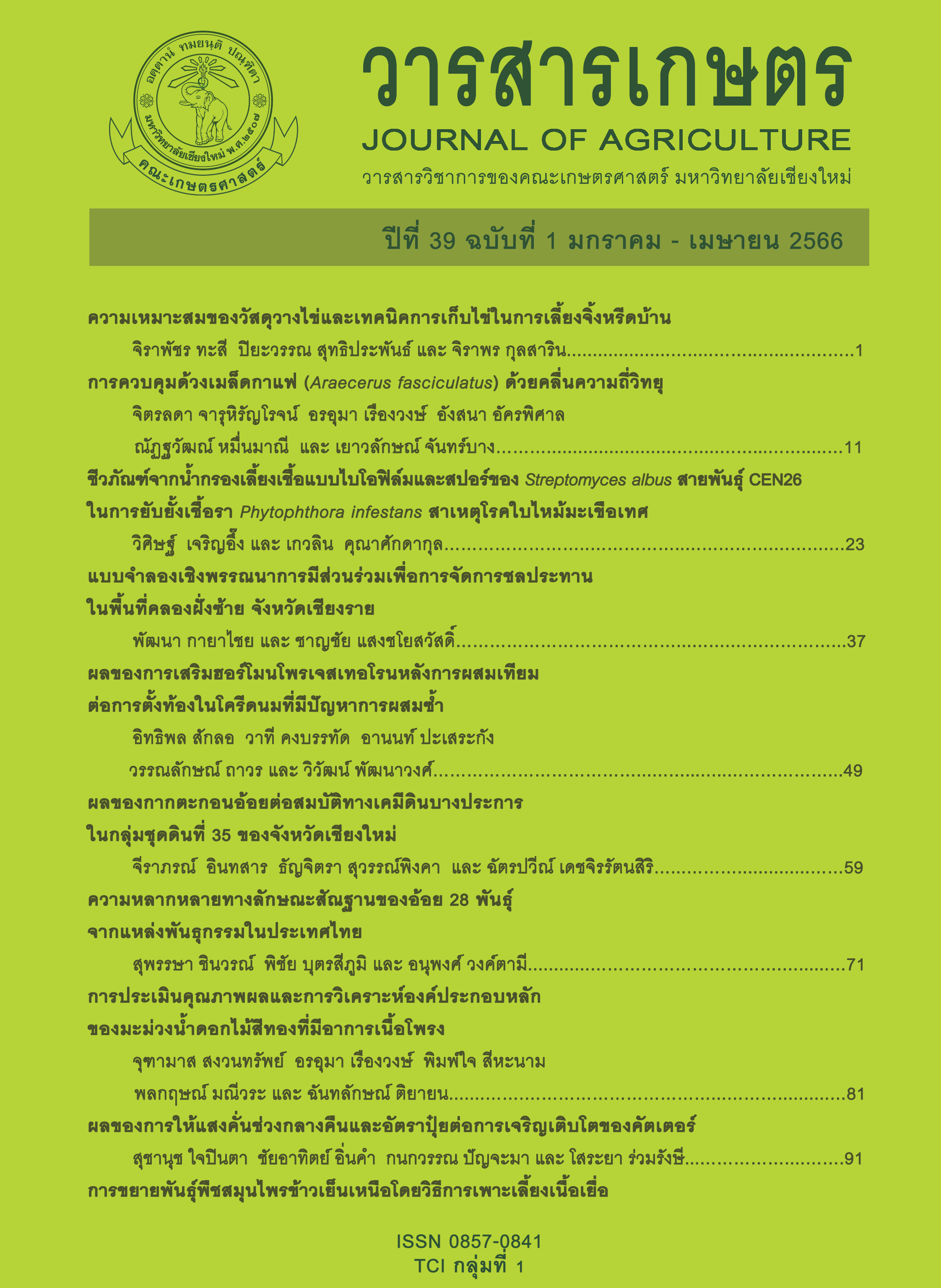ความหลากหลายทางลักษณะสัณฐานของอ้อย 28 พันธุ์ จากแหล่งพันธุกรรมในประเทศไทย
Main Article Content
บทคัดย่อ
การพัฒนาพันธุ์อ้อย (Saccharum officinarum L.) ในประเทศไทยจำเป็นต้องอาศัยแหล่งพันธุกรรมที่หลากหลาย การประเมินลักษณะสัณฐานของพันธุ์อ้อยจึงมีความสำคัญต่อกระบวนการปรับปรุงพันธุ์อ้อยในอนาคต ดังนั้น ในการศึกษานี้มีวัตถุประสงค์ 1) เพื่อประเมินความหลากหลายของลักษณะทางสัณฐาน และ 2) เพื่อจัดกลุ่มความสัมพันธ์ทางลักษณะสัณฐานจำนวน 27 ลักษณะ ของพันธุ์อ้อยจำนวน 28 พันธุ์จากแหล่งพันธุ์ 5 แหล่ง ได้แก่ มหาวิทยาลัยเกษตรศาสตร์ (KU) มหาวิทยาลัยขอนแก่น (KKU) ศูนย์วิจัยพืชไร่สุพรรณบุรี (SBFCRC) ศูนย์วิจัยพืชไร่ขอนแก่น (KKFCRC) และสำนักงานคณะกรรมการอ้อยและน้ำตาลทราย (OCSB) ดำเนินการในฤดูปลูกอ้อยปี 2561/62 ณ แปลงปลูกอ้อยของเกษตรกร ตำบลบ่อทอง อำเภอบางระกำ จังหวัดพิษณุโลก วางแผนการทดลองแบบสุ่มในบล็อกสมบูรณ์ (RCBD) จำนวน 4 ซ้ำ ปลูกอ้อยแต่ละพันธุ์ในแปลงย่อยที่มีแถวอ้อยยาว 8 เมตร จำนวน 4 แถว โดยมีระยะระหว่างแถว 1.65 เมตร แต่ละแถวมี 16 ต้น ประเมินและบันทึกข้อมูลลักษณะทางสัณฐานอ้อย จำนวน 27 ลักษณะ เมื่ออ้อยมีอายุ 8 เดือนหลังปลูก ตาม DUS descriptors จัดกลุ่มความสัมพันธ์ทางลักษณะทางสัณฐานด้วยวิธีการ agglomerative hierarchical cluster (AHC) analysis จากผลการศึกษาพบว่า พันธุ์อ้อยมีค่า HSV = 0.43 (OCSB) - 0.56 (KKFCRC) การจัดกลุ่มความสัมพันธ์ทางลักษณะทางสัณฐาน สามารถจำแนกได้ 4 กลุ่ม ดังนี้ กลุ่มแรก ประกอบด้วยพันธุกรรมอ้อยจำนวน 13 พันธุ์ จาก 3 แหล่งพันธุ์ (OCSB, SBFCRC และ KU) กลุ่มที่สอง ประกอบด้วยพันธุกรรมอ้อยจำนวน 12 พันธุ์ จาก 5 แหล่งพันธุ์ (OCSB, SBFCRC, KKU, KKFCRC และ KU) กลุ่มที่สามและสี่ ประกอบด้วยพันธุกรรมอ้อยจำนวน 2 และ 1 พันธุ์ ตามลำดับ จากข้อมูลความหลากหลายของลักษณะทางสัณฐานวิทยาดังกล่าว มีความสำคัญอย่างมากต่อแหล่งพันธุกรรมอ้อย จึงควรมีกลยุทธ์ที่เหมาะสมในการอนุรักษ์พันธุกรรมเหล่านี้ไว้ สำหรับการปรับปรุงพันธุ์ในอนาคต
Article Details

This work is licensed under a Creative Commons Attribution-NonCommercial-NoDerivatives 4.0 International License.
References
Anonymous. 2009. Specific DUS test guidelines for three notified crops. Plant Variety Journal of India 3(9): 42-54.
Gashaw, E.T., F. Mekbib and A. Ayana. 2016. Genetic diversity among sugarcane genotypes based on qualitative traits. Advances in Agriculture 2016: Article ID 8909506, doi: 10.1155/2016/8909506.
Milligan, S.B., K.A. Gravois, K.P. Bischoffk and F.A. Martin. 1990. Crop effects on genetic relationships among sugarcane traits. Crop Science 30(4): 927-931.
Pinata, P., P. Songsri, N. Jongrungklang and P. Klomsa-ard. 2018. Genetic diversity of yield and agronomic traits in sugarcane germplasm 258 clones. Prawarun Agricultural Journal 15(2): 335-344. (in Thai)
Powers, L.E. and R. McSorley. 2000. Ecological Principles of Agriculture. Delmar Thomson Learning of Albany. 456 p.
Set-tow, S., P. Songsri, N. Jongrungklang and P. Jaisil. 2020. Evaluation of cane yield and agronomic traits of ratoon crops grown in a drought period of 16 rainfed advanced sugarcane clones. King Mongkut’s Agricultural Journal 38(1): 42-51. (in Thai)
Spellerberg, I.F. and P.J. Fedor. 2003. A tribute to Claude Shannon (1916-2001) and a plea for more rigorous use of species richness, species diversity and the ‘Shannon-Wiener’ index. Global Ecology and Biogeography 12(3): 177-179.
Sudianto, E., T.X. Neik, S.M. Tam, T.S. Chuah, A.A. Idris, K.M. Olsen and B.K. Song. 2016. Morphology of Malaysian weedy rice (Oryza sativa): Diversity, origin and implications for weed management. Weed Science 64(3): 501-512.
Chaisan, T. 2020. Development and assessment of modern sugarcane varieties for suitable production areas in each region for increasing sugarcane production improvement. Full Report. The Thailand Research Fund, Bangkok. 325 p.
Thongpaiyai, C., A. Wongpraneekul and P. Chatwachirawong. 2012. Genetic diversity and relationships among commercial sugarcane varieties in Thailand. Khon Kaen Agriculture Journal 40(Suppl. 3): 60-67. (in Thai)
Tippayawat, A., W. Ponragdee and T. Sansayawichai. 2012. Characteristics of Thai sugarcane (Saccharum spp. hybrid) cultivars and potential for utilization. Khon Kaen Agriculture Journal 40(Suppl. 3): 53-59. (in Thai)

